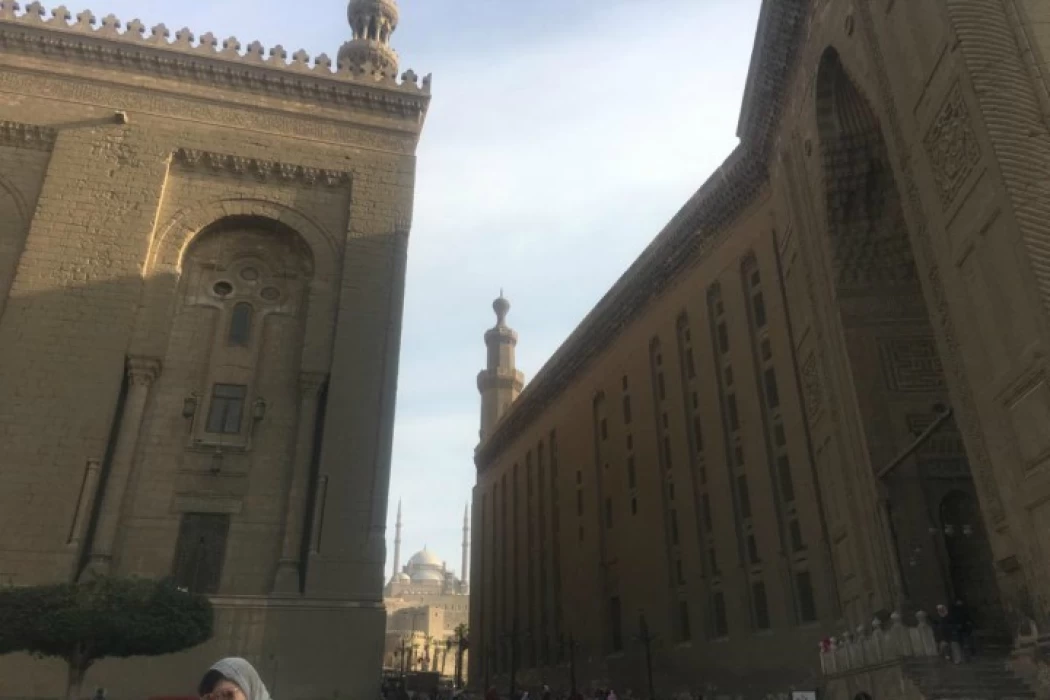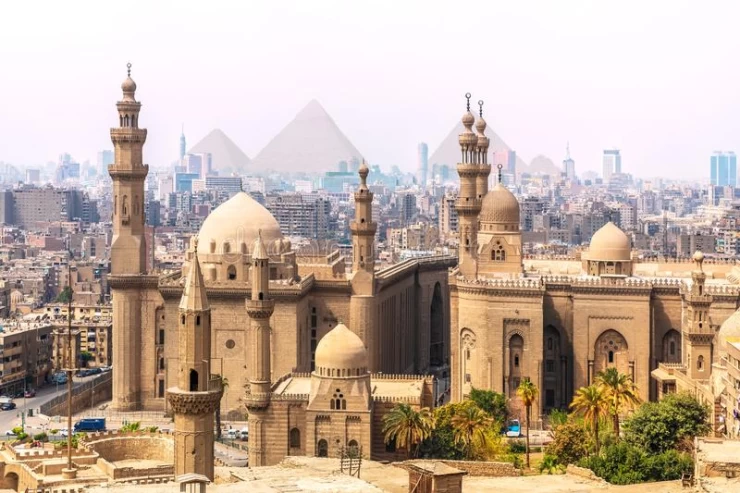
Sultan Hassan Complex
The Sultan Hassan Complex: A Masterpiece of Mamluk Architecture
Tucked into the historic heart of Cairo, Egypt, near the Citadel, the Sultan Hassan Mosque and Madrasa, commonly known as the Sultan Hassan Complex, stands as one of the greatest architectural achievements of the Islamic world. Built during the Mamluk era, this monumental structure not only served religious and educational purposes but also embodied the power, wealth, and artistic sophistication of the Mamluk Sultanate.
Commissioned by Sultan an-Nasir Hassan in the 14th century, the complex has earned international acclaim for its size, architectural innovation, and intricate decorative elements. Even today, it captivates historians, architects, tourists, and spiritual seekers alike. In this article, we will delve into the rich history, architectural features, cultural significance, and enduring legacy of the Sultan Hassan Complex.
Historical Background
The Mamluk Sultanate
The Mamluk Sultanate (1250–1517) was a powerful Islamic regime that ruled over Egypt and the Levant. Known for its military prowess and cultural patronage, the Mamluk era saw an explosion of architectural activity, particularly in Cairo, which became the political, cultural, and religious centre of the Islamic world.
The Mamluks were originally slave soldiers, primarily of Turkic and Circassian origin, who rose to power and established a military elite. Their sultans often commissioned grand mosques, madrasas (Islamic schools), khanqahs (Sufi lodges), and other public works to assert legitimacy and commemorate their reigns.
Sultan an-Nasir Hassan
Sultan Hassan ascended the throne twice during turbulent periods in the mid-14th century. His first reign (1347–1351) was marked by political instability and ended when he was deposed. He regained the throne in 1354 and ruled until his assassination in 1361.
Despite his relatively short and troubled rule, Sultan Hassan is remembered for commissioning one of the most ambitious and artistically significant Islamic architectural projects of the Middle Ages: the Sultan Hassan Mosque and Madrasa Complex.
Construction and Design
Timeline and Challenges
Construction began in 1356 and continued for seven years. The complex was not fully completed by the time of Sultan Hassan's assassination in 1361. It is said that a portion of the minaret collapsed during construction, killing several people, which was seen as a bad omen.
The complex was designed by a team of master architects, engineers, and craftsmen, many of whom were brought from across the Islamic world. The project was financed through the confiscated wealth of plague victims—a fact that contributes to the legend and mystique surrounding its origins.
Layout and Purpose
The Sultan Hassan Complex is a multifunctional Islamic institution. It was designed to include:
- A Congregational Mosque
- A Madrasa for Each of the Four Sunni Schools of Law (Hanafi, Maliki, Shafi’i, and Hanbali)
- A Mausoleum for Sultan Hassan
- A Sabil (public fountain)
- Housing for students and teachers
This multi-purpose design was characteristic of Mamluk architecture, aiming to serve both the living and the dead while asserting religious legitimacy.
Architectural Features
Monumental Scale
The complex is one of the largest Islamic structures in the world. The main facade stretches over 150 meters in length and rises to a height of 36 meters. The minaret, which is among the tallest in Cairo, reaches 68 meters. The massive size was meant to symbolize the authority and grandeur of the sultan.
The Entrance Portal
The monumental entrance portal is a masterpiece of stone carving and Muqarnas (stalactite-like ornamentation). It leads into a bent entrance corridor, a defensive feature used in Mamluk architecture to control access and provide an impressive procession into the space.
The Central Courtyard (Sahn)
At the heart of the complex is a large open-air courtyard, surrounded by four iwans (vaulted halls). Each iwan was dedicated to one of the four Sunni madhhabs. The iwans are decorated with intricate stucco work, marble inlays, and Quranic inscriptions. The use of symmetry and axial alignment creates a sense of harmony and spiritual focus.
The Mihrab and Minbar
The southern iwan contains the mihrab, a prayer niche indicating the direction of Mecca. This mihrab is elaborately adorned with marble panels, mosaic, and gilded inscriptions. Next to it is the minbar, a pulpit used for Friday sermons, made of finely carved wood and mother-of-pearl inlay.
The Mausoleum
Ironically, Sultan Hassan was never buried in the mausoleum he had built for himself. His body disappeared after his assassination, and its whereabouts remain a mystery. Nevertheless, the mausoleum chamber is one of the most architecturally significant parts of the complex. It features a soaring dome and rich decorative elements, intended to ensure the sultan’s remembrance through eternity.
Artistic and Cultural Significance
Decorative Arts
The Sultan Hassan Complex showcases the finest examples of Mamluk decorative arts. Techniques used include:
Stone Carving
Stucco Work
Wooden Screens and Ceilings (Mashrabiya and Muqarnas)
Geometric and Floral Motifs
Calligraphy in Thuluth and Kufic Scripts
These decorations were not merely ornamental but held symbolic and spiritual significance, reflecting the divine harmony and complexity of the universe.
Educational Role
The complex served as a major centre for Islamic education for centuries. It housed scholars and students from different legal schools, promoting intellectual exchange and religious cohesion. The design of separate iwans for each school allowed for simultaneous instruction.
Restoration and Preservation
Over the centuries, the Sultan Hassan Complex has suffered from neglect, natural disasters, and human conflict. Several restoration efforts have been undertaken, especially during the Ottoman and modern Egyptian periods. Today, it is maintained by Egypt’s Supreme Council of Antiquities and is open to the public as both a place of worship and a historical monument.
Contemporary Legacy
The Sultan Hassan Complex continues to inspire awe in those who visit. Its grand scale, rich history, and architectural brilliance make it a symbol of Islamic heritage. It has been featured in countless scholarly works and documentaries and continues to be a major tourist attraction in Cairo.
Moreover, it stands as a living example of how Islamic architecture blended form and function with spiritual and social purpose. It embodies the ideals of unity, discipline, and beauty that underpin Islamic civilization.
The Mosque and Madrasa of Sultan Hassan is one of the most stunning examples of Islamic architecture in Cairo, and it is not surprising that the mosque is situated around the Citadel of Saladin, in the interior of Old Cairo. The complex embodies the epic proportions of Mamluk architecture and is famous for its great scale, beautiful intricate patterns and detail, and its past. Visitors around the globe make pilgrimages to the beauty and history of this architectural and cultural masterpiece, which is the pride of the Mamluk Sultanate.
Historical Overview
This mosque and khanqah compound construction was commissioned by Sultan Hassan bin al-Nasir Muhammad around the year 1356 AD, and he intended it to be more than a mosque as it would serve as a madrasa (school of study) for the four major Sunni sects of Islam: Hanafi, Maliki, Shafi’i, and Hanbali. The construction of the tomb was commenced in the 1356 Christian era, which took around seven years to complete. It was also used as a place to learn and worship. But the bad part was that, alas, within a matter of hours, after the Sultan ordered his last and grandest design, the Sultan was assassinated, thus enhancing the myth.
The complex was built in one of the cities that over the years have suffered many interruptions within its history, internally due to earthquakes as well as military sieges, some of which rendered its architectural design adversely. But it has remained a significant symbol of Mamluk rule and devotion and continues to be open for worship and visitors.
While the Sultan Hassan Complex has much to offer, its enormous scale is undoubtedly the most impressive feature. The main entry that is just under 26 meters in height leads to a courtyard that is surrounded by walls that rise to a height of 36 meters. The entire mosque covered about 7900 square meters, making it one of the biggest mosques in the globe. The building’s symmetrical stone elevation and rich use of geometrical decor and ornamental monuments are typical Mamluk architectural designs.
Also, within the mosque’s interior—except for the one iwab—which houses four schools of Sunni Islam and a large central courtyard, which is encircled by four iwans. The Iwan located at the center pointing to Mecca is enhanced with elaborate stucco work and marbles, as well as a decorated'mihrab.'.’ The courtyard is also properly arranged with the help of vertical members in the form of columns. The guests will also admire the lofty walls of the space, which have curved ceilings, creating an almost ethereal feeling in the room.
The organization, which is popularly referred to as the madrasa or Islamic institution in its primary sense, was one of the objects of the original vision of the complex. So all four iwans also served as classrooms for one of the Sunni judicial schools. This period also explains the presence of such illustrious personages in the inner chambers surrounded by students hailing from every corner of the Muslim world due to its esteem as the pinnacle of education.
The institution committed to the good health of its students as well. This implied that in addition to regular classes being offered, nutrition, dormitories, and a reading room were also provided to the students. The madrasah is covered by Koranic verses placed on the walls as ornaments and motivational resources for the student scholars who were within its confines.
Equally intriguing is the tomb of Sultan Hassan, which is another distinguishing element of the Sultan Hassan Complex. The tomb is in the back of the main prayer room and is said to be one of the best preserved examples of Mumluk burial architecture. The dome is surmounted by a giant dome that is 21 meters in height and is embellished with beautiful arabesques and inscriptions. Based within the mausoleum, there lies the sarcophagus of Sultan Hassan, encased in walls of marble embedded with Mamluk-style masterpieces.
Interestingly, Sultan Hassan’s body was never interred in this mausoleum, as he was killed before the complex was completed, and his remains were buried elsewhere. Nevertheless, the mausoleum remains a symbolic resting place and is a beautiful tribute to his memory.
The Sultan Hassan Complex is a superlative work of Islamic art and architecture, with every detail thoughtfully designed and executed to fit the Mamluk style. The walls and ceilings are clad in arabesques, geometric designs, calligraphy, and other typical components of Islamic art. The fishtail and stucco carving works, embellished on the surfaces, unequivocally demonstrate the exceptional artistry that went into building the entire complex.
Among the dominant artistic aspects, one cannot miss the beautiful wooden mashrabiya, which has elaborate floral and geometric carvings in it, encouraging the eye to explore its design. In addition to enhancing the beauty of the complex, these screens also provide ventilation as well as privacy. Another thing that adds beauty to the mosque is its mihrab, which is made of marble and embellished with decorative panels and mosaics that instill a certain level of spirituality.
















